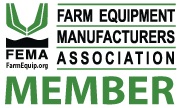Better Hay Baling
Five Common Hay Baling Headaches, and How to Avoid Them
By Mike Ebben
Are you making life as easy as possible during baling season? From crop yield to beating changing weather conditions, baling season is challenging enough. Whether you are baling round or square bales, the right tools will increase efficiency. Below are five common problems and ways to improve bale handling operations, so you can get on to the next thing (because there’s always a next thing), faster.
- Material isn’t feeding properly into the bale chamber. Bale chamber problems are a sign it’s time for maintenance. First, ensure all operators know how to adjust the baler for top quality, then check your baler for damaged parts, such as loose belts or chains and broken or missing pick-up tines. Whether doing the repair in the field or your shop, always disengage the PTO and shut off the engine before dismounting to service your skid steer or tractor. To minimize downtime during hay season, keep pickup tines, chains, bearings, belts and shear bolts on hand for common repairs to minimize downtime.
- You’re tearing or puncturing bale wrappers. To minimize damage, wrapped bales are best handled from the ends where the plastic is thickest. Opt for a hay- bale handler attachment that has a smooth radius, which can efficiently grab both square and wrapped or unwrapped round bales without tearing or puncturing the wrappers.
- Stacking inefficiencies. If storage is at a premium or you simply want to maximize space, using a skid steer loader to move bales is more efficient than a front-end loader because it is easier to maneuver. With a skid steer’s ability to turn on a dime, you can stack bales just about anywhere, such as near posts or other equipment, and opting for a straight arm handler design allows you to stack bales as tight as possible.
- Bales shift during transport. To protect bales from falling during transport, pierced bales are more secure and less prone to dislodging, as compared to a front-end loader spear. Also, using an attachment with removable tines allows you to easily adjust your configuration to the task. And don’t forget preventive maintenance: Tines should be tightened after handling 50 to 75 bales.
- You’re prone to tipping. Since hay crops are often grown on rough or hilly terrain, if your skid steer or tractor is prone to tipping, stop and calculate the weight of the bale and the weight of the carriage, as the total of these shouldn’t exceed the rated capacity of your skid steer or tractor. If the total weigh exceeds your machine’s capacity, don’t risk it. If you don’t have a weigh capacity issue, try keeping the bale load as close to the ground as possible to balance your load.
Mike Ebben is president of Berlon Industries, manufacturer of the Berlon Strong brand of buckets and attachments, including bale handlers and bale spears, for skid steers, tractor loaders, compact tractors, wheel loaders and tele-handlers. The company is online at berlon.com.

Berlon Industries331 Riverview DriveHustisford, WI. 53034920-349-3580
Business Hours:Monday - Friday 7:30 am - 4:30 pm
DEALERS
SOCIAL MEDIA



